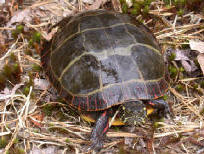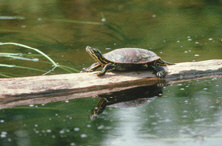Breathless Turtles ...
(3/29/2002)
In early January, I went skating on a small pond in western Massachusetts. A
week or so of cold, dry weather had produced ice that was smooth, more than six
inches thick, and so clear I could see to the bottom of the pond.
Unfortunately, it wasn't until a few weeks after that clear ice had been
clouded by melting and refreezing that Al Richmond, curator of herpetology at
the University of Massachusetts told me he remembers seeing painted turtles
moving under the ice when he was a kid.
 When I heard this, my first thought was to wish I had known to look for them
back in January. My second thought was "How do turtles under the ice get air?" When I heard this, my first thought was to wish I had known to look for them
back in January. My second thought was "How do turtles under the ice get air?"
Turtles are air breathing vertebrates, after all. How would painted turtles
breathe under the ice?
One possibility is that they find pockets of trapped air. That seems pretty
straightforward. But is it enough?
Radio-tracking studies have shown that Dr. Richmond was pretty lucky to see
turtles moving under the ice when he was a kid, an omen, maybe, of his future
career.
Though painted turtles do occasionally move under the ice, mostly what they
do is stay very still. In the northern parts of their range, which extends into
Canada, they sit on the bottom or buried in mud at the edges of lakes, ponds,
and streams, often under ice, from late October to March.
The problem for a such a northerly turtle is this: if you stay out of the
water during the winter, you'll freeze and/or dehydrate and/or be eaten by every
hungry predator. If instead, you retreat to a watery refuge for the cold months,
you'll get very cold, but you won't actually freeze. And though you may still be
susceptible to underwater predators such as otters, you are much safer than on
land.
Unfortunately, ice is impermeable to air. And if you live far enough north
where ice covers lakes, ponds, and rivers for months at a time, you can't come
to the surface to breathe.
So what's a turtle to do?
First of all, stop doing whatever you're doing. In fact, stop doing anything
at all.
Painted turtles sitting on the bottom of a lake don't breathe. For the most
part, they don't move. They don't eat.
Turtles are ectothermic, or what used to be called cold-blooded. Their
temperature depends on their environment, so as the water temperature drops, the
turtle temperature does, too. In an ice-covered pond, the temperature of the
water at the bottom of the pond -- and of the turtles sitting there -- is often
just a few degrees above freezing.
As the temperature drops so does the turtle's metabolism, by as much as 99.4%
-- far greater than the metabolic drop of any hibernating mammal. A cold painted
turtle's heart may beat only once every 5 or 10 minutes.
They are just about as close to being dead as they can get.
Still, they are alive. And if an organism is to stay alive, it must use
energy. Normally, this is done by metabolizing sugars through what is called
aerobic respiration.
Aerobic respiration, however, requires oxygen. In water that has oxygen in
it, a resting, cold-slowed turtle can absorb enough oxygen through its skin to
continue to use aerobic respiration. But in water that becomes oxygen depleted
over the winter, that's no longer possible.
Painted turtles can stay alive even in those waters. How?
There is another way to produce energy, called anaerobic respiration, that
takes place without oxygen. Our muscle cells use this form of energy production
when we are working so hard that we can't get enough oxygen to supply the
muscles.
For a short time, our muscles can operate without oxygen. Turtles use the
same trick when they are under water without oxygen all winter. The problem with
anaerobic respiration is the byproduct lactic acid. When lactic acid builds up
in the blood stream, it lowers the Ph and disrupts blood chemistry.
That's what makes our muscles feel tired after we work them hard. Our body
restores the normal chemistry once we rest. Using oxygen again, it metabolizes
all that built up lactic acid.
But turtles under water can't do this if there's no oxygen.
Instead of using oxygen to get rid of the lactic acid, turtles have buffers
in their blood that neutralize lactic acid and keep it from turning the blood
acidic.
But this only works up to a point. As the winter wears on, lactic acid begins
to overwhelm the blood buffers.
This is the point where the painted turtle separates from the crowd.
Animal Physiologists Gordon Ultsch at the University of Alabama and Donald
Jackson at Brown University, have shown that painted turtles release a substance
called carbonate from their bone into the bloodstream. Carbonate neutralizes the
lactic acid and keeps the turtle's body chemistry in an acceptable range.
Essentially, a painted turtle dissolves its own bones over the winter.
This can only go so far, obviously, or come springtime, a turtle would find
itself without a skeleton. And if the ice cover stays all winter, and the turtle
has to use anaerobic respiration for months at a time, there just isn't enough
carbonate in the bone to neutralize all the lactic acid that is produced.
A turtle's shell, however, is bone fused between the ribs and vertebrae,
covered with a thin layer of skin and scales. A painted turtle's bone and shell
together constitute one third of its total body weight. The turtle uses its bony
shell as an additional source of carbonate to buffer the lactic acid. It's also
able to pull lactic acid out of its blood and trap it within the bone of its
shell.
Using these tricks, painted turtles can live without breathing for five
months or more in water that has absolutely no oxygen -- longer than any other
known air-breathing vertebrate. The only other vertebrate that comes close is,
another turtle, the Snapping Turtle.
That's why, once you get far enough north that ponds and lakes freeze over
for months at a time, the only turtles you'll find everywhere are painted
turtles and snapping turtles.
Other turtles are limited to water that remains oxygenated all winter.
Generally, this means large lakes, rivers, and some smaller lakes and ponds that
have steadily flowing water. steadily flowing water.
Being able to overwinter in virtually any body of water that doesn't freeze
solid gives painted turtles and snapping Turtles a big advantage.
So if you see a painted turtle early in spring in a northern climate, stand
back and give the poor thing some air. It may be taking it’s first real breaths
– and getting its first oxygen – since November.
|